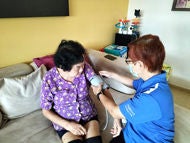What is - Kidney Failure
The kidneys are a pair of bean-haped organs in the back of the body. Each kidney is attached to the bladder, which is a distensible bag that collects urine. The kidneys make the urine, which flows downward through two tubes called the ureters, and collects in the bladder. Kidneys that function normally keep in balance many things in the body by altering the composition of urine that they produce.
The kidneys:
- control the amount of salt and water in the body.
- get rid of many waste products of the body in the urine.
- enable the body to form adequate blood cells by producing a substance called erythropoetin.
- regulate and maintain the health of the bones.
- control the acid levels in the body as well as many other minerals and salts of the body.
 Given the large number of roles the kidneys play in maintaining a person's health, it is easy to see how many symptoms can develop among patients with kidney failure. The kidneys are critical for survival; without them, patients develop multiple problems. These may range from excessive fluid retention, breathlessness, sleeplessness, a poor appetite and high blood pressure.
Given the large number of roles the kidneys play in maintaining a person's health, it is easy to see how many symptoms can develop among patients with kidney failure. The kidneys are critical for survival; without them, patients develop multiple problems. These may range from excessive fluid retention, breathlessness, sleeplessness, a poor appetite and high blood pressure.
Symptoms of Kidney Failure
The kidneys have a large reserve and a large amount of kidney must be damaged even before a person has symptoms of renal disease. For this reason a patient may have significant kidney damage but still feel perfectly well, see a doctor only very late in the course of his disease. A patient with mild kidney failure may initially not feel anything at all and in fact may feel totally well. However, as the kidney disease progresses, symptoms become more apparent. Patients may develop:
- High blood pressure
- Swelling of the legs (called oedema)
- Breathlessness
- General symptoms of poor sleep, loss of appetite and lethargy
- A bad smell in the breath called a uraemic fetor
- Cramps
- Numbness of the feet
- Passing a lot of urine especially at night (called nocturia), or conversely too little urine.
- Chronic generalised itch
- Blood in the urine, which usually reflects the underlying kidney disease
- Soapy urine or frothy urine, which reflects the presence of protein in the urine
Not all patients develop all these symptoms. Some develop these symptoms during different stages of their disease. Also, it is important to realise that these symptoms do not necessarily only mean that one has kidney disease. Each disease affects each patient differently and to different extent.
Kidney Failure - Causes and Risk Factors
There are many causes of kidney disease and these affect the kidney to different degrees, causing them to fail at different rates. Some of these are inherited, and while others are related to existing conditions such as diabetes, and other inflammatory conditions or infections. A list of causes of kidney failure is provided.
- Diabetic nephropathy
This is kidney failure from long-standing and poorly-controlled diabetes. It is now the most important cause of end-stage renal disease in Singapore and elsewhere in the world. Patients with diabetes mellitus commonly have many other associated problems. These include heart attacks, strokes, eye disease, gangrene, numbness of the feet, and rapid swings in blood pressure from a lying to standing position. They are also prone to infections of the abdomen, skin, ears and feet. ( link to Endocrinology). - Chronic glomerulonephritis
This refers to a group of different kidney diseases that initially affect a specific microscopic structure of the kidney called the glomerulus. The most common form is called Ig A (pronounced as I G A) nephropathy. This kidney disease can take from 3 to 40 years before reaching end-stage renal disease. There are many others as well (focal and segmental glomerulosclerosis, membranous glomerulopathy, membranoproliferative glomerulonephritis, to name a few). - Polycystic kidney disease
This is a form of inherited kidney disease associated with the development of multiple sacs of fluid (cysts) within the substance of the kidney. These patients tend to develop hypertension, kidney stones, and recurrent urine infection or infections of the cysts of the kidney. They can have other associated problems, the most serious of which is a rupture of the blood vessels of the brain (called a leaking berry aneurysm), which can bring on a sudden and severe headache. - Lupus Nephritis
Patients with immune disorders called systemic lupus erythromatosus (SLE) commonly develop kidney disease. The patterns of kidney disease vary widely and their responses to therapy vary. Patients with SLE suffer usually from many other manifestations of their disease. These include hair loss, joint pains especially of the hands, wrists and knees, facial rash, mouth ulcers and involvement of the gut, lungs and blood. - Reflux nephropathy
This is another inherited disease characterised by recurrent urine infection in childhood associated with a backwash of urine from the bladder upward into the kidney during urination. This leads to kidney scarring, loss of kidney tissue and kidney failure.
Diagnosis of Kidney Failure
Kidney disease can be so silent in the early stages that the patient may be perfectly well without any symptoms. However, apart from a physical check up, patients usually need urine and blood tests to detect renal disease.
The urine is usually tested for:
- the presence of blood, a condition known as haematuria.
- the presence of protein or proteinuria
- cellular debris (also called casts)
The blood is tested also for abnormally high levels of substances that accumulate in the body in the presence of kidney failure. They include:
- the blood urea level
- the blood creatinine level
- other substances such as potassium and bicarbonate
Usually the initial screening tests can be done at a clinic with a sample of freshly collected urine. The urine is tested using a labstix. The labstix is a stick to which is adhered several chemicals strips which change their colour when there is abnormal amounts of blood, protein or sugar in the urine. In the presence of abnormal labstix testing, patients may need to collect their urine for 24 hours to allow the attending doctor to better assess the urine to confirm or exclude any urinary abnormality. Some patients may eventually need a kidney biopsy to distinguish the kind of kidney disease that they have, as well as to assess the eventual renal prognosis. A kidney biopsy is a minor surgical procedure in which a needle is inserted into the kidney (with anaesthesia) and a piece of the kidney is taken for microscopic examination.
It is important to realise that the presence of a single abnormal lab result does not necessarily equate to the presence of renal disease. An abnormal laboratory result implies that the patient needs to see a doctor. The doctor may consider either a repeat test or more extensive testing for the patient.
While any patient can benefit from having these tests done, there remain certain groups of persons who are at higher risk of renal disease who should in particular have regular renal function tests.
These groups include patients with:
- hypertension
- diabetes mellitus
- gout
- a history of haematuria (blood in the urine)
- recurrent urine infections
- a history of protein in the urine
- a family history of kidney disease
Treatment for Kidney Failure
Once kidney failure reaches a certain degree, it usually will progress to end stage kidney failure. Nevertheless, there are some common treatment that can benefit most patients with established kidney disease.
General Measures
- Treat hypertension (high blood pressure): It is important that high blood pressure is treated. Apart from medication that a patient should take regularly, the patient should also restrict his salt intake, and try to lose weight. Regular clinic visits or home blood pressure monitoring gives the doctor the needed information so that blood pressure treatment can be adjusted to suit the patients needs and achieve appropriate blood pressure levels. Apart from reducing the progression of renal failure, blood pressure control has the important added advantage of reducing the risk of heart attacks and strokes,
- Anti-proteinuric therapy: Some kidney diseases are associated with protein loss in the urine. Certain medications can decrease / lower the amount of protein excreted in the urine. This group of drugs (called angiotensin converting enzyme inhibitors) needs to be prescribed by the doctor. These drugs are usually prescribed more commonly in the early stage of renal disease. While on this treatment, the patient will need to have regular checks of the kidney function. This group of medications can effectively reduce the progression of renal disease. Not all patients are suitable for this form of treatment, nor do all patients tolerate this medication equally well. They can be associated with intolerable cough, and like any medications, may cause some patients to develop an allergic rash.
The information provided is not intended as medical advice. Terms of use. Information provided by SingHealth.
Condition Treated At
Department
Renal Medicine
Department
Renal Medicine
Department
Renal Medicine
Department
Dietetics



















